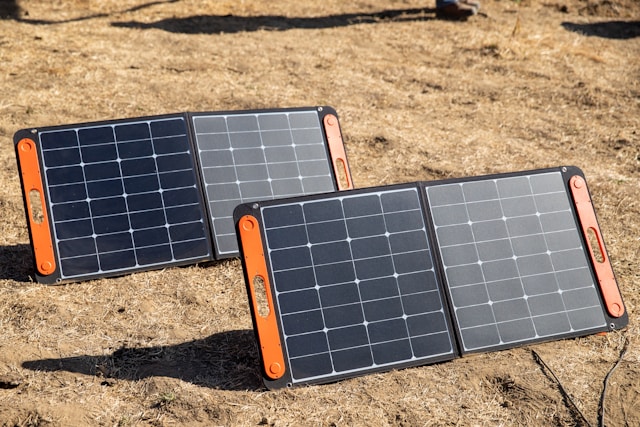Portable solar panels have evolved from niche gadgets to essential tools for adventurers, eco-conscious households, and emergency-preparedness enthusiasts alike. In 2025, these compact energy solutions are smarter, lighter, and more versatile than ever, offering a bridge between sustainability and modern convenience. But with endless options flooding the market, how do you pinpoint the ideal match for your energy needs? Let’s dive into the latest innovations, top-rated models, and expert insights to help you make an empowered choice.

By the end of this guide, you’ll uncover the best portable solar panels tailored to 2025’s demands, learn how to balance performance with affordability, and explore why solar energy isn’t just a trend—it’s a lifestyle shift.
Ready to tap into the sun’s limitless potential? Let’s illuminate your path to energy independence. ☀️
Why Portable Solar Panels Are Redefining Energy Access
Gone are the days when solar power was confined to rooftop installations. Today’s portable panels are designed for dynamic lifestyles, whether you’re backpacking through national parks, hosting a backyard gathering, or safeguarding your home against blackouts. Their rise isn’t accidental—advancements in photovoltaic technology and battery storage have transformed them into must-have gear.
A Brief Evolution:
While the first solar cells of the 1950s were clunky and costly, modern iterations boast sleek, foldable designs and military-grade durability. Innovations like monocrystalline cells and MPPT charge controllers now maximize efficiency, even in low-light conditions.
Why They’re Indispensable in 2025:
- Resilience: Weatherproof models thrive in rain, snow, or desert heat.
- Portability: Ultra-lightweight frames (some under 10 lbs!) fit effortlessly into backpacks.
- Versatility: Charge everything from smartphones to RV batteries with adaptive outputs.
- Eco-Savings: Slash reliance on fossil fuels while cutting long-term energy costs.
Solar Energy’s Surge in the U.S.: What 2025 Holds
The U.S. solar industry is booming, driven by federal incentives, falling costs, and a cultural shift toward sustainability. The Solar Energy Industries Association (SEIA) predicts solar will account for 30% of U.S. electricity by 2030, with portable panels playing a pivotal role in decentralized energy systems.
Key Drivers for Adoption:
- Affordability: Panel prices have plummeted 80% since 2010, making solar accessible to all.
- Policy Support: Extended tax credits (now 30% through 2032) and state rebates sweeten the deal.
- Tech Breakthroughs: Thin-film solar and modular designs enhance portability without sacrificing power.
- Climate Urgency: With extreme weather events rising, off-grid energy is no longer optional—it’s a lifeline.
Choosing Your Solar Sidekick: 5 Must-Check Features
Picking the best portable solar panels means aligning specs with your lifestyle. Here’s your cheat sheet:
- Wattage Wisdom:
- 20–50W: Ideal for phones, lights, and small devices.
- 100W+: Powers laptops, mini-fridges, or CPAP machines.
- Pro Tip: Calculate daily energy needs (in watt-hours) to avoid underpowered setups.
- Design & Portability:
- Foldable vs. rollable: Foldables (like books) save space; rollables (like mats) are lighter.
- Handles, kickstands, and daisy-chaining options add convenience.
- Durability:
Opt for corrosion-resistant aluminum frames and IP65+ waterproof ratings for rugged use. - Battery Integration:
Panels with built-in storage (e.g., 500Wh batteries) ensure power after sundown. - Smart Tech:
Bluetooth monitoring, USB-C/PD ports, and wireless charging are 2025’s game-changers.
2025’s Standout Solar Panels: Power Meets Innovation
After rigorous testing, these five models shine brightest in performance, durability, and value:
- Goal Zero Nomad 20 (Updated 2025 Edition)
- Best For: Minimalists and backpackers.
- Upgrades: 25% lighter than predecessors, with rapid-charging USB-C.
- Price: 169–220
- EcoFlow DELTA 2 Solar Bundle
- Best For: Full-home backup or RV living.
- Perks: 400W output, 1-hour full recharge, and app-controlled energy management.
- Price: $1,199
- Renogy 100W Eclipse S
- Best For: Balance of power and portability.
- Standout: Scratch-resistant surface + 25% efficiency boost in partial shade.
- Price: $279
- Jackery SolarSaga Pro 100W
- Best For: Newbies and weekend warriors.
- Why We Love: Plug-and-play setup; pairs seamlessly with Jackery’s power stations.
- Price: $319
- Bluetti PV200 Max
- Best For: Daily drivers and van-lifers.
- Edge: 23.4% efficiency rate, plus compatibility with third-party generators.
- Price: $549
Maximizing Your Solar Investment: Pro Tips
- Sun Tracking: Use a sun-tracking app to position panels at optimal angles hourly.
- Storage Smarts: Keep lithium batteries at 50% charge if unused for months.
- Winter Hacks: Clear snow promptly and angle panels steeper to capture weak sunlight.
Maintenance Musts:
- Clean panels biweekly with a microfiber cloth and vinegar solution.
- Check connections for corrosion; silicone seals prevent moisture damage.
Beyond Savings: The Ripple Effect of Solar Adoption
Choosing the best portable solar panels isn’t just about convenience—it’s a vote for a cleaner future. Each kilowatt generated offsets 1.5 lbs of coal, and with millions adopting solar, collective impact soars. Economically, panels can pay for themselves in 2–3 years via energy savings, especially as utility rates climb.
Final Spark: Embrace the Solar-Powered Lifestyle
2025 marks a tipping point where solar tech meets everyday practicality. Whether you’re chasing sunsets on a cross-country road trip or fortifying your home against outages, portable panels offer freedom and resilience.
Don’t just follow the trend—lead it. Explore our top picks, compare specs, and join the movement toward cleaner, smarter energy. The sun isn’t setting on this revolution; it’s just rising.